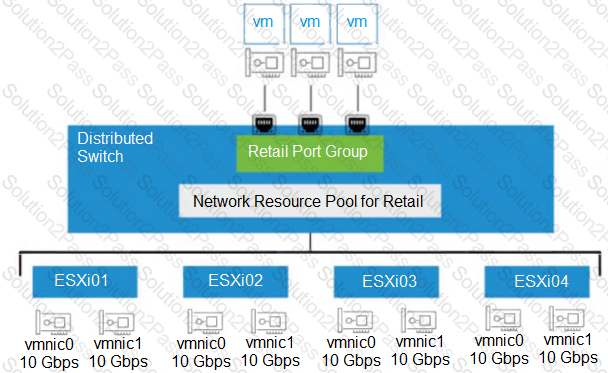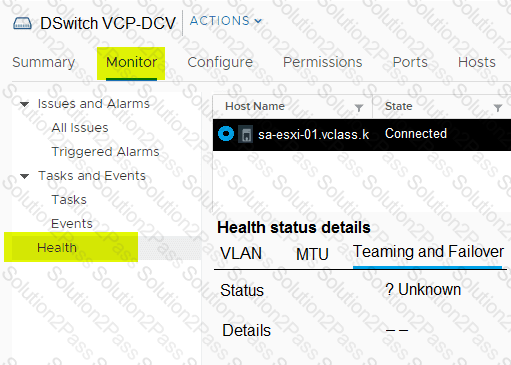2V0-21.23 VMware vSphere 8.x Professional Free Practice Exam Questions (2025 Updated)
Prepare effectively for your VMware 2V0-21.23 VMware vSphere 8.x Professional certification with our extensive collection of free, high-quality practice questions. Each question is designed to mirror the actual exam format and objectives, complete with comprehensive answers and detailed explanations. Our materials are regularly updated for 2025, ensuring you have the most current resources to build confidence and succeed on your first attempt.
An administrator has a requirement to revert a running virtual machine to a previous snapshot after a failed attempt to upgrade an application. When the administrator originally took the snapshot the following choices in the Take Snapshot dialog were made:
Snapshot the virtual machine’s memory = false
Quiesce guest file system = false
What will be the result of the administrator selecting the ‘Revert to Latest Snapshot?
option to return the virtual machine to a previous snapshot?
An administrator is configuring vSphere Lifecycle Manager to install patches to a vSphere cluster. The cluster runs workload virtual machines (VMs) that are incompatible with vSphere vMotion, and therefore cannot be live migrated between hosts during the installation of the patches.
Which configuration in vSphere Lifecycle Manager will allow the administrator to reduce the downtime associated with the patching operation without migrating the VMs?
An administrator has configured Storage I/O Control (SIOC) on a Virtual Machine File System (VMFS) datastore.
•The datastore supports 30,000 IOPS
•Storage I/O Control has been set to manual
•Storage I/O Control is triggered when latency hits 30 ms
•The datastore contains 3 virtual machines (VMs)
•A gold tier VM
•A silver tier VM
•A bronze tier VM
Assuming the datastore latency does not exceed 29ms, what is the maximum number of IOPS the bronze tier VM is entitled to?
An administrator is completing the configuration of a new vSphere cluster and has enabled vSphere High Availability (HA) and vSphere Distributed Resource Scheduler (DRS).
After adding the ESXi hosts to the cluster, which networking information will the administrator be prompted to provide when using the Cluster Quickstart workflow?
Refer to the exhibit.

An administrator set up the following configuration:
• The distributed switch has four ESXi hosts, and each host has two 10 Gbps NICs.
• In the Network I/O Control configuration, the amount of bandwidth reserved for virtual machine (VM) traffic if 4 Gbps.
The administrator wants to guarantee that VMs in the Retail distributed port group can access 50 percent of the available reserved bandwidth for VM traffic.
Given this scenario, what should the size (in Gbps) of the Retail network resource pool be?
An administrator is asked to segregate virtual machine (VM) traffic by VLAN on a vSphere standard switch The following requirements must be met:
•VLAN ID on the switch port group must be 4095.
•VLAN tagging must be done at the VM level.
Which tagging mode is required?
Exhibit switch

An administrator configures a distributed switch and adds the first VMware ESXi server to it.
The administrator also performs the following activities:
•The administrator assigns two uplinks to the distributed switch.
•The administrator enables uplink teaming.
When attempting to perform a health check of the teaming policy, the health status of the Teaming and Failover reports as ' Unknown?, as seen in the exhibit.
What can the administrator changes in the distributed switch for the health status to report correctly?
What are two uses cases for VMware Tools? (Choose two.)
An administrator is tasked with implementing a backup solution capable of backing up the Supervisor cluster, vSphere Pods, and persistent volumes.
Which two solutions must be used to meet this requirement? (Choose two.)
A VMkernel port is labelled PROD01 and uses the default TCP/IP stack. Currently, this VMkernel port is configured for supporting live virtual machine (VM) migrations.
Which configuration change should the administrator make to isolate live VM migration traffic from other network traffic?
An administrator manages VM templates and ISO images for a remote office. Their main requirements are to store these templates in a single repository and manage different versions of the templates.
What solution should the administrator deploy to meet these requirements?
An administrator plans to update the Supervisor cluster and has noticed some of the Tanzu Kubemetes Grid clusters are running an incompatible version.
Which action must the administrator take before proceeding with the Supervisor cluster update?
A vSphere cluster has the following vSphere Distributed Resource Scheduler (DRS) group configuration:
* Virtual machine (VM) group named DB
* Host groups named PROD11 and PROD55
The administrator wants to force the VMs in the DB group to run on the hosts in the PROD11 group. However, if all the hosts in PROD55.
Which VM/Host rule must the administrator create to ensure that these requirements are met?
If a distributed switch uses the "Route based on physical NIC load" load balancing algorithm, what does the mean send or receive utilization of an uplink need to exceed for the flow of traffic to move to the second uplink?
Which VMware offering will allow an administrator to manage the lifecycle of multiple vCenter Server instances in a single software as a service (SaaS)-based solution to help drive operational efficiency?
An administrator is tasked with allowing a single user the ability to take snapshots on a virtual machine. When looking in vCenter, the administrator can see that there are already users and groups assigned permissions on the virtual machine as follows:
•The group VMJJsers has the Virtual Machine Power User role.
•The group VM_Viewers has the Read Only role.
The administrator confirms that the user requesting the additional access is currently one of five members of the VM_Viewers group
Which two steps should the administrator take to grant this user the additional access required without impacting the user access of others? (Choose two.)
An administrator is creating a content library to manage VM templates and ISO images. The administrator wants to password-protect the images and templates and share them with a remote site.
Which two tasks must the administration perform when creating the content library? (Choose two.)
An administrator is required to configure several Microsoft Windows virtual machines (VMs) to support Secure Boot for a critical secure application.
The following information is provided:
•The corporate security policy states that all forms of data encryption must utilize a key provider.
•The firmware of each VM is currently set to use Unified Extensible Firmware Interface (UEFI).
•Due to the nature of the application running within the VMs, the guest operating system for each VM is currently a minimum of Windows Server 2008 and Windows 7.
Which security feature should the administrator implement to meet these requirements?
A company has two sites: Site A and Site B. The administrator would like to manage the VMware vCenter inventories in both sites from a single vSphere Client session.
Which vCenter feature must be configured?
Which three features are only available when using vSphere Distributed Switches instead of vSphere Standard Switches? (Choose three.)
